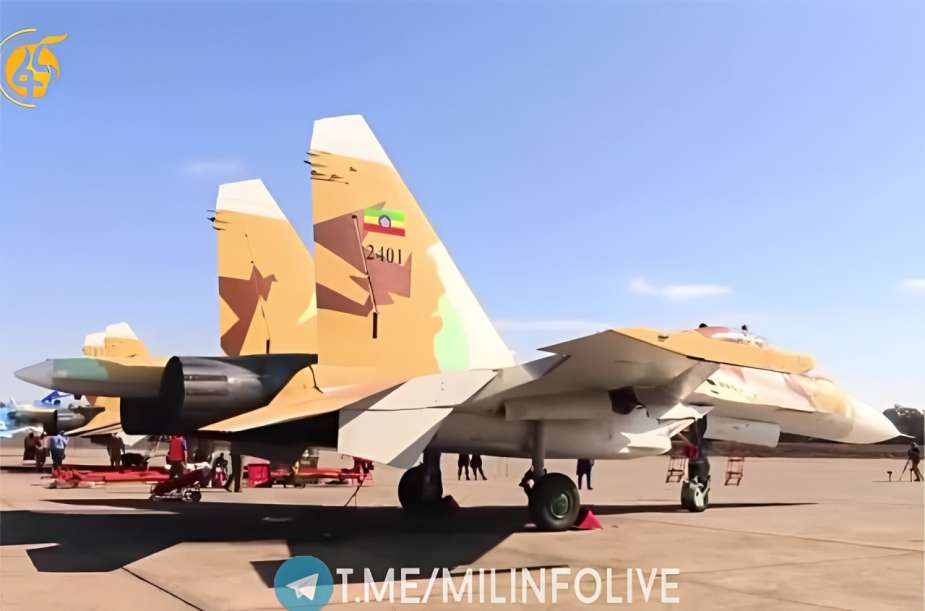Breaking news
Ethiopia receives two ex-Indian Su-30K fighter jets from Russia.
As reported on Russian social media on January 17, 2024, the Ethiopian Air Force has received two Su-30K fighter jets, raising questions and interest due to the history and background of these aircraft. These aircraft were originally part of a batch of 18 fighters previously used by the Indian Air Force, and this acquisition by Ethiopia had not been disclosed earlier.
Follow Air Recognition on Google News at this link
 Derived from the Su-27UB, these Su-30K fighters represent a transitional model of the Indian version of the Su-30MKI, manufactured by the Irkutsk Aviation Plant in Russia. (Picture source: Telegram)
Derived from the Su-27UB, these Su-30K fighters represent a transitional model of the Indian version of the Su-30MKI, manufactured by the Irkutsk Aviation Plant in Russia. (Picture source: Telegram)
The origins of these aircraft can be traced back to the production of 18 Su-30K fighters at the Irkutsk Aviation Plant in Russia, which were initially intended for delivery to India under the Su-30MKI program, based on agreements reached in 1996 and 1998. Between 1997 and 1999, the Indian Air Force received these Su-30K aircraft. However, a significant development occurred in December 2005 when an agreement led to their return to the Russian manufacturer in exchange for the supply of 18 new Su-30MKI fighters to India.
Following their return, these aircraft were transported to Belarus, specifically the 558th Aviation Repair Plant in Baranovichi, for storage and potential modernization. In 2013, all the aircraft from this batch underwent repairs and upgrades in Belarus, and in 2017, Angola acquired 12 of these Su-30Ks, leaving the remaining six without designated buyers. Despite reports of Ethiopia's interest in purchasing these remaining aircraft, there has been no official confirmation of the contract, leaving questions about the fate of the four additional Su-30Ks in storage.
The unveiling of the acquisition of these first-generation Su-30K fighters by Ethiopia took place on January 16, 2024. The aircraft now bears Ethiopian tail numbers "2401" and "2402," as seen in photographs. These aircraft originally served as Su-30Ks in the Indian Air Force and have apparently undergone various transformations since their return from India.
Derived from the Su-27UB, these Su-30K fighters represent a transitional model of the Indian version of the Su-30MKI, manufactured by the Irkutsk Aviation Plant in Russia. In contrast to the more advanced Indian Su-30MKI, the Su-30K lacks an open architecture for avionics, necessitating the placement of new equipment in external containers due to limited internal volume.
While details regarding the modifications and capabilities of the aircraft that underwent upgrades in Belarus remain undisclosed, it is worth noting that Ethiopia already possesses a substantial inventory of Soviet and Russian-made military equipment, including 11 single-seat Su-27S/SK fighters and 2 double-seat Su-27UBs.
Ethiopia's acquisition of these Su-30K fighter jets comes at a time when Russian weapon exports face increasing challenges due to American restrictions under the CAATSA law and other sanctions. Such deals may assist Russia in filling gaps in its export revenue, particularly with alternative buyers, such as Iran or financially stable African nations, in mind.
The Su-30K is an export variant of the Sukhoi Su-30, a twin-engine, two-seat fighter aircraft developed by Russia's Sukhoi Aviation Corporation. The Su-30 is designed for all-weather, air-to-air, and air interdiction missions. Originally, the Su-30 project evolved from the Sukhoi Su-27 family and was renamed from the Su-27PU to Su-30 in 1996. The Su-30 has been developed in various versions, including export variants, to meet the requirements of different countries.
It is equipped with in-flight refueling capabilities and a GPS and GLONASS satellite navigation system. Notably, it lacks the front horizontal tail found in later versions of the Su-30. Its combat capabilities include the ability to engage air targets with short-range R-73 missiles, as well as high-precision missile weapons such as the X-29 and X-31 series, which can be used against both ground and naval targets at distances of up to 250 km. The Su-30K can also utilize long-range television-guided missiles like the Kh-59M, along with adjustable aerial bombs such as the KAB-500 and KAB-1500.
One of the key features of the Su-30 is its high maneuverability, aided by thrust vectoring control and a digital fly-by-wire system, allowing it to perform advanced maneuvers like the Pugachev's Cobra and tailslide. Some versions include canards for enhanced maneuverability and control, although this adds some drag and slightly reduces maximum speed.
The Su-30 is powered by two Saturn AL-31F after-burning low-bypass turbofan engines, providing it with a maximum speed of Mach 2 and a range of up to 3,000 kilometers. The aircraft can carry a variety of weapons, including air-to-air missiles, air-to-surface missiles, anti-ship missiles, anti-radiation missiles, and various bombs. It is armed with a 30 mm autocannon.
The aircraft is equipped with advanced avionics, including radar systems like Bars N011M and Myech, as well as electro-optical targeting systems, helmet-mounted display systems, and radar warning receivers. Finally, the Su-30 is widely used by various countries, including Russia, Algeria, Vietnam, and India, and it continues to be in service and production.


























